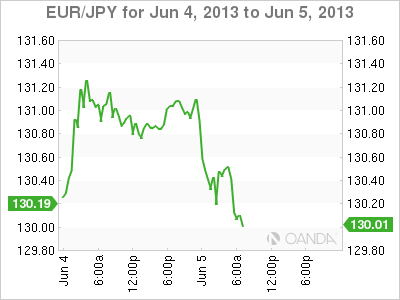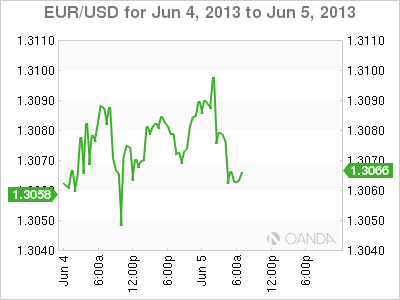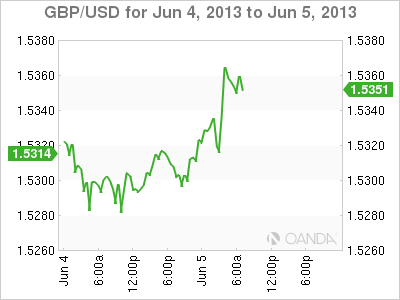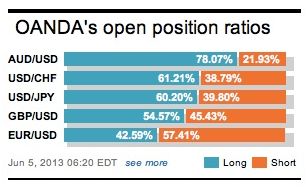So far this week we have seen that Monday’s Euro PMI reports have been tentatively supporting a market view that the Euro-zone downturn is stabilizing. Interestingly, the IMF’s Christine Lagarde has a different viewpoint. She believes that the recent global economic data is showing us a “somber trend” and sees the global economy entering a “softer patch” as downside risks “remain prominent.” For the Europeans, the natural outlier remains Germany – the anointed backbone of Europe – where attention remains focused on whether there are any positive surprises from the recent flash PMI releases for May.
Despite the Euro region remaining in a recession, Monday’s manufacturing activity data was surprisingly strong for the bloc’s more troubled economies – Spain, Italy and Greece. Even Germany is threatening to enter expansion territory again. Nevertheless, even with a strong link there is a weak link and France remains the ‘big four’ economic lagger with its manufacturing PMI print just above that of Greece’s (46.4). Compiled data released today reveals that business activity in the Euro-zone continues to fall last month – proof maybe that the IMF’s Lagarde is more accurate in her assessment and that the Euro’s long slump will continue.
Markit’s 47.7 gauge of activity across manufacturing and services for the 17-member Euro-zone remains in contraction territory, but “shrank at the least severe rate in three-months.” The fortunes amongst member states again were mixed, with Germany revised higher to show marginal growth. A pleasant surprise was Spain, where contraction was at its “least severe” in 24-months. The reduction in manufacturing activity was moderate across the Euro-zone, but services (which accounts for a larger share for European output) were as expected, “patchy” – the decline worsening in Italy and a surprise no improvement in Germany or France.
An optimist would have us believe that “signs of stabilization in business activity in Germany and lesser declines amongst other nations” gives us hope for an end to the regional economic slump. However, so far the member states continue to lack the consistent growth drivers to boost the combined member economies beyond the stabilization phase. This morning’s Euro retail sales headline supports this argument. It fell sharply in April (-0.5% – the third straight month of decline and the largest in six-months), which suggests that consumer spending or demand that rose in Q1 is “running out of steam.” Household spending has fallen in each quarter since the contraction started in Q4 in 2011. 
The ‘single’ currency reaction has been somewhat muted, the PMI’s quite rightly failed to provide fuel for a run on stops above the 1.3110 mark. The weak Euro-zone retail sales saw a run to the Euro-session lows but again has failed to ‘up’ momentum into a quiet market that seems to be patiently waiting for US ADP data for solid direction.
The market is anticipating an ADP Employment reading of +165k for May, above the +119k print in April. Investors will be looking to today’s employment print for a gauge on Friday’s ‘granddaddy of releases’ – the NFP print. With all of the talk about a Fed taper, particularly strong labor market data would further fuel anticipation that the Fed will reduce QE purchases sooner rather than later, “potentially worsening any resulting sell-off in rates.”
Earlier this morning, the UK economy has managed to complete its own “hat trick” of above forecasts for May PMI’s, with manufacturing, construction and this morning’s services PMI’s report. The improvement in the three areas suggests that a mild UK recovery is underway. The dominant services sector grew at the fastest pace in more than a year last month (54.9 vs. 52.9) – a trend that is likely to continue as new orders increased at the fastest pace in three-years. This bodes well for economic data in the months ahead and should provide a solid footing for Q2 GDP’s print. This is not expected to sway the BoE rate announcement from outgoing Governor Mervyn King tomorrow. 
In truth, the market is more concerned about what the new BoE Governor, Mark Carney, will be doing once he assumes command. Data like this diminishes the likelihood of any shift in policy under Carney in the first few months of his tenure. Cable has managed to hit a fresh day high on the news (1.5370), while against the EUR it hit a new daily low (0.8507).
Capital markets most crowded trade is threatening to unravel a tad – long the Nikkei and short the Yen. Japanese equities fell sharply overnight after PM Abe’s growth strategy speech disappointed, again weighing on sentiment across Asia. He delivered the latest in a series of speeches in which he outlined a wide ranging program – raising real GDP growth, increasing capital spending by +10% over the next three-years – of legislative change designed to complement the BoJ’s stimulus that is defining his Abenomics agenda. Investors were unimpressed with the plan and managed to push the Tokyo index into its fifth decline greater than -3% in the past two-weeks. 
The market seems to have one primary legitimate focus and it’s on this Friday’s US Payrolls – which is intense to say the least. Investors should expect this market intensity to be keeping the major pairs trading back and forth in a relatively tight range from here on in, despite the ECB and BoE yet to deliver their rate announcement until tomorrow. Remember, this market will not want to go home tomorrow evening with any large trading positions ahead of North American job numbers – it’s prudent to pare. 
- English (UK)
- English (India)
- English (Canada)
- English (Australia)
- English (South Africa)
- English (Philippines)
- English (Nigeria)
- Deutsch
- Español (España)
- Español (México)
- Français
- Italiano
- Nederlands
- Português (Portugal)
- Polski
- Português (Brasil)
- Русский
- Türkçe
- العربية
- Ελληνικά
- Svenska
- Suomi
- עברית
- 日本語
- 한국어
- 简体中文
- 繁體中文
- Bahasa Indonesia
- Bahasa Melayu
- ไทย
- Tiếng Việt
- हिंदी
EURO Data Dulls Major Pairs Ahead Of Jobs
Published 06/05/2013, 08:19 AM
Updated 07/09/2023, 06:31 AM
EURO Data Dulls Major Pairs Ahead Of Jobs
Latest comments
Loading next article…
Install Our App
Risk Disclosure: Trading in financial instruments and/or cryptocurrencies involves high risks including the risk of losing some, or all, of your investment amount, and may not be suitable for all investors. Prices of cryptocurrencies are extremely volatile and may be affected by external factors such as financial, regulatory or political events. Trading on margin increases the financial risks.
Before deciding to trade in financial instrument or cryptocurrencies you should be fully informed of the risks and costs associated with trading the financial markets, carefully consider your investment objectives, level of experience, and risk appetite, and seek professional advice where needed.
Fusion Media would like to remind you that the data contained in this website is not necessarily real-time nor accurate. The data and prices on the website are not necessarily provided by any market or exchange, but may be provided by market makers, and so prices may not be accurate and may differ from the actual price at any given market, meaning prices are indicative and not appropriate for trading purposes. Fusion Media and any provider of the data contained in this website will not accept liability for any loss or damage as a result of your trading, or your reliance on the information contained within this website.
It is prohibited to use, store, reproduce, display, modify, transmit or distribute the data contained in this website without the explicit prior written permission of Fusion Media and/or the data provider. All intellectual property rights are reserved by the providers and/or the exchange providing the data contained in this website.
Fusion Media may be compensated by the advertisers that appear on the website, based on your interaction with the advertisements or advertisers.
Before deciding to trade in financial instrument or cryptocurrencies you should be fully informed of the risks and costs associated with trading the financial markets, carefully consider your investment objectives, level of experience, and risk appetite, and seek professional advice where needed.
Fusion Media would like to remind you that the data contained in this website is not necessarily real-time nor accurate. The data and prices on the website are not necessarily provided by any market or exchange, but may be provided by market makers, and so prices may not be accurate and may differ from the actual price at any given market, meaning prices are indicative and not appropriate for trading purposes. Fusion Media and any provider of the data contained in this website will not accept liability for any loss or damage as a result of your trading, or your reliance on the information contained within this website.
It is prohibited to use, store, reproduce, display, modify, transmit or distribute the data contained in this website without the explicit prior written permission of Fusion Media and/or the data provider. All intellectual property rights are reserved by the providers and/or the exchange providing the data contained in this website.
Fusion Media may be compensated by the advertisers that appear on the website, based on your interaction with the advertisements or advertisers.
© 2007-2024 - Fusion Media Limited. All Rights Reserved.
